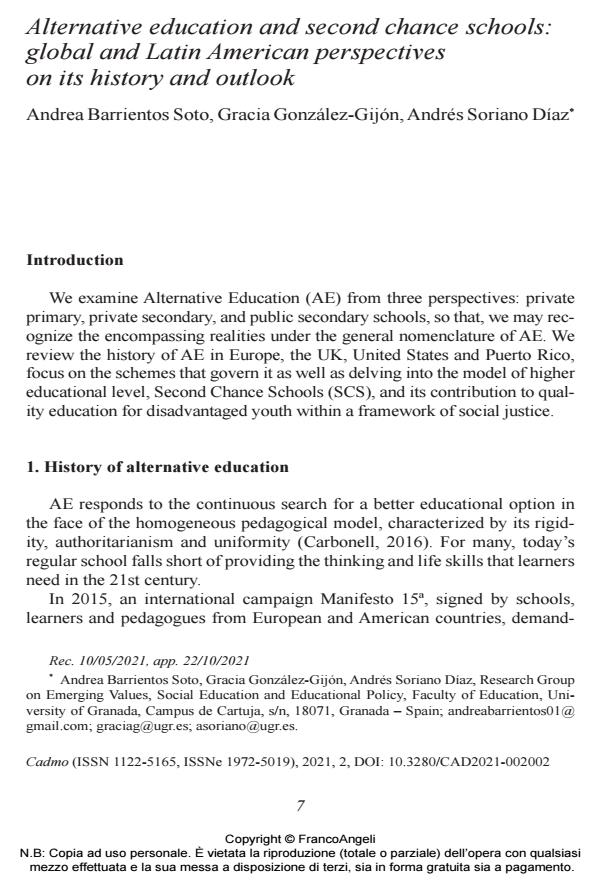Alternative education and second chance schools: global and Latin American perspectives on its history and outlook
Journal title CADMO
Author/s Andrea Barrientos Soto, Gracia González-Gijón, Andrés Soriano Díaz
Publishing Year 2022 Issue 2021/2
Language English Pages 14 P. 7-20 File size 225 KB
DOI 10.3280/CAD2021-002002
DOI is like a bar code for intellectual property: to have more infomation
click here
Below, you can see the article first page
If you want to buy this article in PDF format, you can do it, following the instructions to buy download credits

FrancoAngeli is member of Publishers International Linking Association, Inc (PILA), a not-for-profit association which run the CrossRef service enabling links to and from online scholarly content.
Alternative Education has become a tool for inclusion for young people with particular needs not normally addressed in homogeneous schools. This article presents a theoretical review of its history, its typology and the organizational schemes used as it correlates to the regular school system. We review the impact of Alternative Education’s Second Chance Schools on student performance and retention based on the experience in Latin America, Europe and the US.
Keywords: alternative education, disadvantaged youth, early school leaving, history of education, second chance schools.
- AERO – Alternative Education Resource Organization (2020), The Ten Signs You Need to find a Different Kind of Education for Your Child, -- retrieved from: https://www.educationrevolution.org/ .
- AEA – Alianza para la Educación Alternativa (2012), Informe Anual. San Juan: AEA.
- Alliance for Self-Directed Education (2021), What is Self-Directed Education?, -- retrieved from: https://www.self-directed.org/sde/.
- Alumnos de la Escuela Barbiana (1986), Carta a una Maestra. Barcelona: Hogar del Libro.
- Barrientos Soto, A., González Gijón, G., Soriano Díaz, A. (2017), “A Perspective on Alternative Education in Puerto Rico”, The International Journal of Humanities Education, 15 (2), pp. 17-27, -- retrieved from: https://cgscholar.com/bookstore/works/a-perspective-on-alternative-education-in-puerto-rico?category_id=cgrn.
- Barrientos Soto, A. (2020), Educación Alternativa y la formación de sus docentes. Madrid: Dykinson.
- Cámara de Representantes de Puerto Rico (2012), Ley Habilitadora para el Desarrollo de la Educación Alternativa Proyecto 3865 Ley 213, -- retrieved from: http://www.lexjuris.com/lexlex/Leyes2012/lexl2012213.htm.
- Carbonell, J. (2016), Pedagogías del siglo XXI. Barcelona: Octaedro.
- Deeds, C., DePaoli, J. (2017), Measuring Success: Accountability for Alternative Education. Washington DC: American Youth Policy Forum.
- Del Pozo, F., Jiménez, F., Barrientos Soto, A.. (2018), “Pedagogía Social y Educación Social en Colombia”, Revista Zona Próxima, 29, pp. 32-51, -- retrieved from: http://rcientificas.uninorte.edu.co/index.php/zona/article/view/9086.
- Departamento de Educación del Estado Libre Asociado de Puerto Rico (DEPR) (2014), Proyecto CASA. Puerto Rico, -- retrieved from: https://www.de.pr.gov/servicios-de-ayuda-al-estudiante/proyecto-casa-para-estudiantes-en-alto-riesgo/.
- European Commission (2013), Preventing Early School Leaving in Europe. Lessons Learned from Second Chance Education. Brussels: European Union.
- Freire, P. (1993), The Pedagogy of the Oppressed. London: Penguin Books.
- García, A. (2016), Otra Educación ya es posible. Madrid: Litera Libros.
- Glassett, S., Daniels, E. (2014), “Understanding Alternative Education”, Education Leadership Review of Doctoral Research, 1 (1), pp. 106-121.
- Hostos, E.M. (1969), Liga de Patriotas Puertorriqueños, En Puerto Rico Madre Isla. San Juan: Editorial Coquí.
- Lange, C., Sletten, S. (2002), Alternative Education: Brief History and Research Synthesis. US Department of Education, -- retrieved from: http://alternatyvusisugdymas.lt/uploads/2009/12/alternative_ed_history.pdf.
- Miller, R. (2004), A Map of the Alternative Education Landscape, -- retrieved from: https://www.educationrevolution.org/store/resources/alternatives/mapoflandscape/.
- Mills, M., McGregor, G. (2017), Alternative and Non-formal Education. In Oxford Research Encyclopedia, -- retrieved from: https://oxfordre.com/education/view/10.1093/acrefore/9780190264093.001.0001/acrefore-9780190264093-e-40.
- National Alternative Education Association (2009), Promoting High Quality Alternative Education, -- retrieved from: https://olis.leg.state.or.us/liz/2017I1/Downloads/CommitteeMeetingDocument/148863.
- Neill, A.S. (1986), Summerhill. Barcelona: EUMO.
- OECD (2012), Equity and Quality in Education: Supporting Disadvantaged Students and Schools, -- retrieved from: http://dx.doi.org/10.1787/9789264130852-en.
- Palladino, J. (2021), Fannie Lou Hamer Freedom School, -- retrieved from: https://www.flhfhs.org/apps/pages/index.jsp?uREC_ID=1510247&type=d&pREC_ID=1650366.
- Porowski, A., O’Conner, R., Luo, J. (2014), How do States define Alternative Education?, US Dept. of Education, -- retrieved from: https://files.eric.ed.gov/fulltext/ED546775.pdf.
- Quintero, A. (2009), “Breve historia de la educación en Puerto Rico”. In Enciclopedia de Puerto Rico, -- retrieved from: https://enciclopediapr.org/.
- Raywid, M. (1994), “Alternative schools: The state of the art”, Educational Leadership, 52 (1), pp. 26-31.
- Roberson, L. (2015), Perceptions of Educators Regarding the Effectiveness of Alternative Programs, Doctoral Dissertation. Nova Southeastern University.
- Sliwka, A. (2012), The Contribution of Alternative Education. Paris: OECD, -- retrieved from: http://www.oecd.org/education/ceri/40805108.pdf.
Andrea Barrientos Soto, Gracia González-Gijón, Andrés Soriano Díaz, Alternative education and second chance schools: global and Latin American perspectives on its history and outlook in "CADMO" 2/2021, pp 7-20, DOI: 10.3280/CAD2021-002002